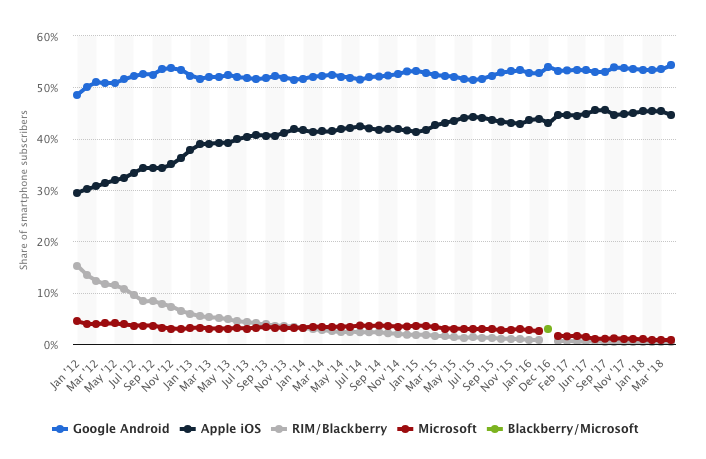What’s Your SaaS Competitive Advantage?
In a recent post on SaaS growth strategies, we discussed something significant that influences SaaS conversion rates: your market position and competitive advantages. We need to be careful here — we could easily write forever on this topic. But, we have SaaS companies to help grow, and you have a company to focus on growing, too. Here, we’ll quickly review what a SaaS competitive advantage is and how you can strengthen your own.
First, what is a market position? It’s how your customers (i.e., subscribers) perceive you in comparison to other companies that provide the same or similar type of product or offering.
A common yet infinitely analyzable example is Microsoft versus Apple. Both offer consumer and business technology products, but the perception of each is markedly different. Apple is perceived as trendy, cultural, advanced, modern, well designed, and so on. When it comes to consumer products like smartphones, Apple and Google’s Android platforms lead the way, with Apple trending upward since 2012. But compared to Microsoft? Apple is leagues ahead:
Microsoft shares many of the same traits as Apple, but it could be argued that they’re not as broadly applied across all its business areas — particularly in their consumer products (RIP Windows Phone), with the exception of the Xbox. However, Microsoft leads the way in B2B products due to their lower cost, customization, flexibility, reliability, frequent updates, and a vast array of productivity tools.
Both of these companies have strong competitive advantages over the other in different areas. Where one falls short, the other excels — and they know it. More importantly, they leverage it. Windows advertising (among others) is seemingly always after Apple in the consumer products area. But if Apple ever attempted console gaming? Or a more solid B2B offering? They’d likely find themselves playing catch-up to Microsoft.
Apple and Microsoft are loose examples. Sure, they offer SaaS products, but that’s not their entire business model. In the world of a growing SaaS company, you won’t be dropping millions of dollars on finely tuned, rib-jabbing advertising that tries to sway people to you. You’ll be advertising, but more importantly, you’ll be learning from your prospects, customers, and lost customers about why your product is great — or why it isn’t. You’ll need to put this information to use in making your business and your product more compelling.
Considerations for Improving Your SaaS Competitive Advantage
You should have an understanding of your market position simply by virtue of having created your SaaS product. You wouldn’t undertake the complex development of software without having an idea of what’s missing in the market, right? Of course not. And if you’ve previously raised capital through VC sponsorship or elsewhere, your business plan and market position would have been carefully reviewed by investors. To be direct, you probably wouldn’t be where you are without having an understanding of your market position.
That said, it’s something worth constantly revisiting to ensure you’re keeping pace with your competitors — and ideally outpacing them. Here are some thoughts for improving your market position.
- What does your brand say about you? Is it accurate? Does it reflect your culture, offering, and so on? Is it understandable? Can prospects and subscribers understand what it means and promises them? If your brand doesn’t tell the world who you are, why you’re here, what you have to offer, and what it matters, consider revisiting it.
- How does your product help your subscribers? Your competitors created a similar product, so why should people subscribe to yours instead of theirs? What’s unique about your product that’ll help subscribers solve their challenges? If your product can’t solve a problem for your subscribers in a way that’s easier, friendlier, simpler, and more pleasant than competitors’ options, why should they bother with yours?
- How do you expand upon your relationships? What else can subscribers expect from you apart from your product and support? Do you provide a service that enhances the offering? Do you offer tiers of your product for smaller versus larger businesses? Can you (and are you willing) to accommodate subscribers’ unique needs for the platform? What else can you offer your subscribers that competitors can’t?
- How are you keeping subscribers happy? Customers want to hear from you — whether directly or even through periodic communications. Create checkups. Make service calls to see how they’re doing and what could be improved in their experience. Remember, your subscribers are paying for more than your platform. They’re paying for you. Make sure you and your team are accessible in some way that provides your subscribers with a delightful experience — one they’ll be willing to share with others.
Go deeper: Download our guide to growing your SaaS business in a competitive market.
Applying for Capital? Be Prepared to Talk Unique Value
Subscribers aren’t the only ones that want to know what your SaaS competitive advantage is — venture debt financing lenders will need to understand what your SaaS competitive advantage is as well.
This is often outlined in your business plan or other establishment documentation, but if not, consider performing some market research to identify where you stand against other competitors and what your unique value proposition is. This is important because your SaaS competitive advantage will consist of the critical factors that will contribute to your growth.
If you’re ready to take your market position to the next level and reach even more subscribers, our team is ready to help. Fill out the form below to speak with one of our investment team members, or apply online today.






